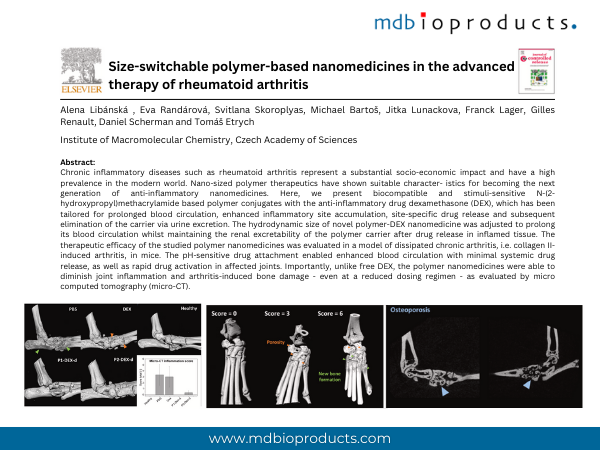
Featured Publication in Focus: Size-switchable polymer-based nanomedicines in the advanced therapy of rheumatoid arthritis
Apr 19 , 2024
Authors:
Alena Libánská , Eva Randárová, Svitlana Skoroplyas, Michael Bartoš, Jitka Lunackova, Franck Lager, Gilles Renault, Daniel Scherman and Tomáš Etrych
Institute of Macromolecular Chemistry, Czech Academy of Sciences
Journal of Controlled Release. Science Direct
----------------------
Products referenced:
Catalogue # 804001-lyo
Collagen Type II, Bovine, Immunization Grade, Lyophilized, 10 mg
Catalogue # 501009
Complete Freund's Adjuvant, 4 mg/mL (5 mL)
Catalogue # 501011
Incomplete Freund's Adjuvant (IFA), 5 mL
----------------------
ABSTRACT
Chronic inflammatory diseases such as rheumatoid arthritis represent a substantial socio-economic impact and have a high prevalence in the modern world. Nano-sized polymer therapeutics have shown suitable character- istics for becoming the next generation of anti-inflammatory nanomedicines. Here, we present biocompatible and stimuli-sensitive N-(2-hydroxypropyl)methacrylamide based polymer conjugates with the anti-inflammatory drug dexamethasone (DEX), which has been tailored for prolonged blood circulation, enhanced inflammatory site accumulation, site-specific drug release and subsequent elimination of the carrier via urine excretion. The hydrodynamic size of novel polymer-DEX nanomedicine was adjusted to prolong its blood circulation whilst maintaining the renal excretability of the polymer carrier after drug release in inflamed tissue. The therapeutic efficacy of the studied polymer nanomedicines was evaluated in a model of dissipated chronic arthritis, i.e. collagen II-induced arthritis, in mice. The pH-sensitive drug attachment enabled enhanced blood circulation with minimal systemic drug release, as well as rapid drug activation in affected joints. Importantly, unlike free DEX, the polymer nanomedicines were able to diminish joint inflammation and arthritis-induced bone damage - even at a reduced dosing regimen - as evaluated by micro computed tomography (micro-CT).
To continue reading and to download the publication: https://doi.org/10.1016/j.jconrel.2022.11.027
